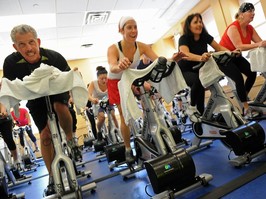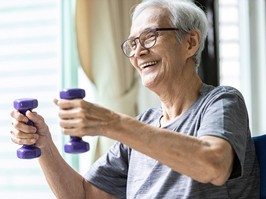if this round of covid-19-related gloom has hit a little harder, i feel the same. maybe it’s the brutal weather. maybe it’s the worry over not knowing when all-things-pandemic will end. either way, the start to 2022 has been rough, and it has me wanting to find healthy things to do that don’t involve just hanging out at home, or working — adding more exercise into my daily routine was one of my goals.but when it announced that gyms — including the one in my condo building — would have to close as part of the ontario government’s latest restrictions, my fitness options became exercising in my living room with limited equipment, or braving the cold for a run or possibly jumping jacks in the local park.and while venturing out in frigid conditions may not be your idea of a fun workout, there are a lot of benefits to winter workouts, including increased calorie burn, better endurance and a stronger immune system.
five good things about a winter workout
mental health. exercise is
good for your mental health in any season. but in the winter, and in particular this winter, focusing on supporting our mental health is as important as ever with seasonal depression — also known as
season affective disorder (sad) — affecting more of us than usual. sad symptoms usually start in late fall or winter and occur at about the same time of year, every year, and exercising regularly is one of the best ways to combat them.many experts believe sad is also partially as result of a lack of vitamin d, so getting outside the exercise during the day in the winter gets you that much-needed sunlight to help battle symptoms.
fat burning. no matter how many calories you burn at the gym or indoors, you can expect to burn more in colder temperatures with the same workout. the body likes to keep its core temperature at a comfortable 37 degrees celsius, so when it’s hot, we sweat to cool that temperature down and when it’s cold, we shiver to warm up.but the body can’t shiver forever, so after a few minutes we start to convert white fat cells, used for energy storage, into
calorie-melting brown fat through a process called
non-shivering thermogenesis. the body also burns more calories at rest in cold temperatures than warm ones.
better workouts. an important part of an effective workout is making sure you warm up and cool down properly. exercising in colder weather makes sure you get that cool down period just by being outside, and the cold also naturally stiffens and tightens muscles, forcing you to warm up a bit before reaching your peak performance.cold-weather exercise also exposes you to different kinds of routines or activities that you won’t be able to do for the rest of the year. activities such as skiing, skating, snowshoeing, or cold-water swimming activate different muscles and make the body react in different ways than you might be used to.
improved endurance. if you have a healthy heart, cold-weather exercise can help strengthen it further because the heart works harder in colder temperatures to pump blood through the body. note though, that while that extra stress on the heart may help a healthy heart, it
can be dangerous for people with poor cardiovascular health.rates of mortality from a cardiovascular event tend to increase in colder months, so those with hypertension or coronary heart disease should probably avoid working out in the cold.
boosted immune response. it has been well-documented that
exercise can boost your immune system —and the colder season is when we need all the help we can get to cold and flu germs.
but before you get outside…
while working out in the cold can provide a host of unique benefits, there are still some steps you should take to make sure you’re doing it safely.
dress for the weather. wear layers to stay warm during the workout, but make sure they are light and can be easily removed as you heat up. you also need to stay warm to avoid the dangers of frostbite in extreme cold. wear a hat, gloves and warm socks to protect your extremities as blood flows away from those body parts to keep your core warm.footwear is also important, particularly those with good traction to battle slippery conditions and avoid falling, slipping and potential injury.
stay hydrated. even though it’s cold outside, you will still sweat once your body heats up so it’s important to replenish those fluids. you might not feel thirsty due to the cold, but make sure to drink up anyway.
wear sunscreen. even though it’s winter, you still need to protect yourself from the harm of ultraviolet rays. snow can also worsen the effects by reflecting the rays back onto your skin — you’ll still get all the vitamin d you need with sunscreen on.
nick beare is a toronto-based freelance writer. he can be reached here. thank you for your support. if you liked this story, please send it to a friend. every share counts.
 4 minute read
4 minute read








